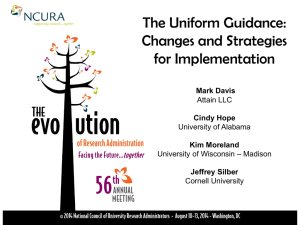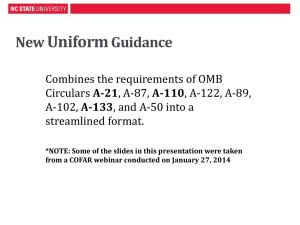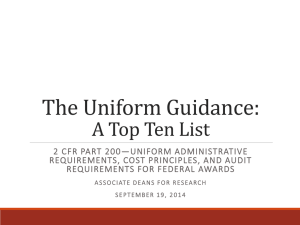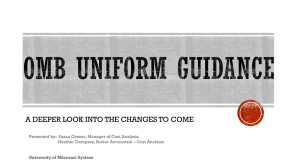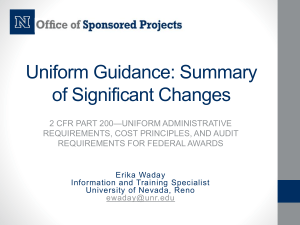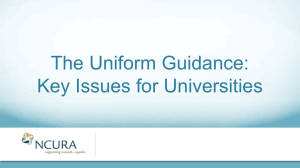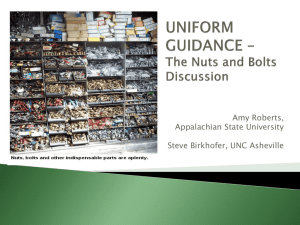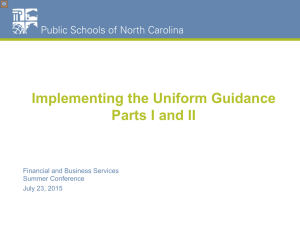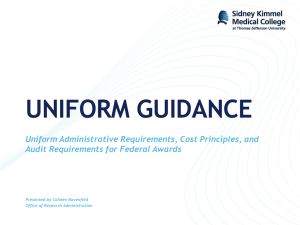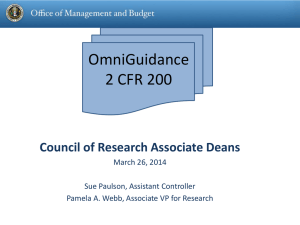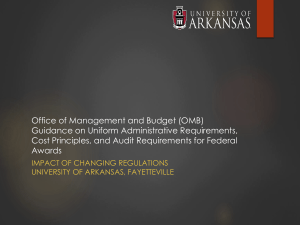Changes and Strategies for implementation
advertisement
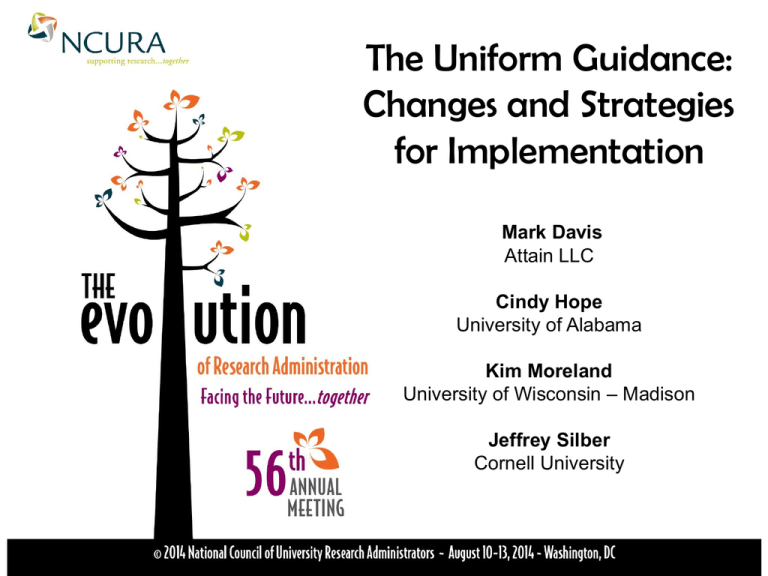
The Uniform Guidance: Changes and Strategies for Implementation Mark Davis Attain LLC Cindy Hope University of Alabama Kim Moreland University of Wisconsin – Madison Jeffrey Silber Cornell University Topics Introduction to the Guidance Subawards and Closeouts Fringe Benefits and Effort Reporting Purchasing and F&A Issues Examples: Direct Cost Items Questions THE UNIFORM GUIDANCE 2 Research Administrators With Blindfolds The Uniform Guidance: What do you see? THE UNIFORM GUIDANCE 3 Subawards and Closeouts Cindy Hope Assistant Vice President for Research University of Alabama Subrecipient Monitoring & Management – 200.330-332 Highlights More prescriptive requirements More documentation of risk assessment and monitoring will likely be expected Fixed price subawards limited to Simplified Acquisition Threshold (currently $150,000) Must use subawardee’s negotiated F&A rate or, absent a negotiated rate: Negotiated a rate or Provide 10% “de minimis” rate THE UNIFORM GUIDANCE 5 Subrecipient and contractor determinations – 200.330 Pass-through entities must make determinations. Good! “Contractor” has replaced “vendor” Characteristics of a subrecipient and of a contractor (vendor) have not changed 200.93 Subrecipient means a non-Federal entity that receives a subaward from a pass-through entity to carry out part of a Federal program; but does not include an individual that is a beneficiary of such program. A subrecipient may also be a recipient of other Federal awards directly from a Federal awarding agency. Federal agencies may supply and require specific support for determinations! THE UNIFORM GUIDANCE 6 Requirements for pass-through entities – 200.331 All pass-through entities must… Federal Award Identification Indirect Cost Rate Evaluate Subrecipient Risk • List of information required to be included in each sub • More elements, many related to FFATA • Some odd (eg amount of prime) • If the sub has a federally recognized, negotiated rate, use it! • If not, negotiate a rate or use the “de minimis” rate of 10% MTDC • Factors to consider may include sub’s: • Previous experience • Audits • Personnel/system changes • Monitoring by federal agencies THE UNIFORM GUIDANCE 7 Requirements for pass-through entities - 200.331 All pass-through entities must… (d) Monitoring of the subrecipient must include: ◦ ◦ ◦ ◦ Review financial and programmatic reports Related to the Federal award provided from the pass-through: Ensure appropriate action is taken when deficiencies are detected Issue management decisions* when the subrecipient has audit findings (f)&(g) Still required to verify compliance with Subpart F, Audit*, and adjust own records if necessary *Improvements at the federal level are anticipated (FAQ II-4) THE UNIFORM GUIDANCE 8 Requirements for pass-through entities – 200.331 All pass-through entities must… (e) Based on assessed risk, these monitoring tools may be useful for the pass-through: Training and technical assistance, on-site reviews, agreed-upon procedures audits (c) Consider imposing specific subaward conditions (.207) (h) Consider taking enforcement action against noncompliant subs (.338) THE UNIFORM GUIDANCE 9 Fixed amount subawards – 200.332 Fixed amount awards defined at 200.45 “a specific level of support without regard to actual cost incurred” Accountability based primarily on performance & results Allowed “With prior written approval from the Federal awarding agency” “up to the Simplified Acquisition Threshold” Defined at 200.88, currently $150,000 THE UNIFORM GUIDANCE 10 Fixed amount subawards – 200.332 Like now, amount of award is negotiated based on cost: 200.201 - may use fixed amount subawards where there is adequate data “to establish a fixed amount award with assurance that the non-Federal entity will realize no increment above actual cost” Like now, amount charged is not based on cost: 200.400(g) - the non-Federal entity may not earn or keep profit But 200.401 - section 200.4XX (E – Cost Principles) does not apply to Fixed amount awards THE UNIFORM GUIDANCE 11 Subrecipient Monitoring & Management – 200.330-332 What can we do now? A lot. At UA: Implement subrecipient versus contractor checklist Maybe Express version and Full version Update subrecipient award checklist Include additional Fed award elements, progress reporting requirements Formalize risk assessment documentation Update sub invoice PI approval form Any required technical reports have been reviewed and are appropriate Watch FDP for revised subaward forms, model risk assessment, etc. THE UNIFORM GUIDANCE 12 Closeout – 200.343 No stated change for recipient, but… All reports due “no later than 90 calendar days after the end date of the period of performance” New circumstances Pressure on agencies (OMB 7/2012 Controller Alert) Subaccounting (NSF, NIH, others) Enforcement through 90 days for cash draw Closeout is the focus of a new FDP/COGR group THE UNIFORM GUIDANCE 13 Fringe Benefits and Effort Reporting Jeffrey Silber, Senior Director Sponsored Financial Services Cornell University Fringe Benefits § 200.431 Compensation – fringe benefits Part of this section is similar to what existed in A-21 § J.10.f UG focuses on compliance with formal policies and law, consistent treatment across fund sources, and appropriate allocation across institutional activities. Subsection (b)(3)(i) was a surprise. Clarification is being sought, but language as written would result in additional costs to universities. THE UNIFORM GUIDANCE 15 § 200.431 (b) (3) (i) “When a non-Federal entity uses the cash basis of accounting, the cost of leave is recognized in the period that the leave is taken and paid for. Payments for unused leave when an employee retires or terminates employment are allowable as indirect costs in the year of payment.” Institutions managing benefits on an accrual basis (i.e. incorporating them in the benefit rate) may be unaffected THE UNIFORM GUIDANCE 16 What this might mean … If it is an “indirect cost” an alternative charging mechanism will be required, administrative burden is increased and most universities will receive little or no recovery due to the administrative cap. If it is charged indirectly (i.e. via a benefit rate) then an alternative charging mechanism will be required, increasing administrative burden, however there will be recovery. If this is intended only to be a default mechanism, then we may be able to continue charging leaves directly as many of us do today. THE UNIFORM GUIDANCE 17 What this might mean … Subsection 200.431 (e) (3) suggests that “workers' compensation, unemployment compensation, severance pay, and similar employee benefits (e.g., postretirement health benefits)” might also have to be treated as an indirect cost, which would have similar impact. This is in the “wait and see” category, as COGR, FDP, and others work with OMB and COFAR for clarification. THE UNIFORM GUIDANCE 18 Cost principles are “family friendly” For what I believe is the first time in a “circular” § 200.431 mentions “familyrelated leave.” The sensitivity of the guidance to family needs is also seen in § 200.432 and elsewhere. This needs to be consistent with institutional policy, as applied to all funding sources THE UNIFORM GUIDANCE 19 Effort reporting 200.430 Compensation - Personal Services For decades higher ed, under A-21, has dealt with the “Examples of Acceptable Methods for Payroll Distribution” Even though merely “examples” we [and auditors] have accepted as axiomatic, for example, that plan confirmation must certify at least annually, but after-the-fact must certify at least every academic period. THE UNIFORM GUIDANCE 20 200.430 Compensation - Personal Services Like certain other aspects of the Uniform Guidance, this section is less prescriptive. The examples, for example, are gone. Instead, subsection (i) sets forth “Standards for Documentation of Personnel Expenses.” These standards offer latitude in implementation, but the concept of documenting salaries in some fashion is alive and well. THE UNIFORM GUIDANCE 21 Standards for Documentation of Personnel Expenses Internal control based Part of official institutional records Reflect total activity, and both federal and non-federal work Support distribution among multiple fund sources If based on estimates must be periodically adjusted and controls must support after-thefact review THE UNIFORM GUIDANCE 22 Effort Certification: Summary A cynic might suggest that the requirements sound like we’re not getting rid of our effort reporting systems in the near future. BUT … Clearly there is more latitude to design a system based on your institution’s controls Cognizant agencies “are encouraged to approve alternative proposals based on outcomes and milestones for program performance….” Many are awaiting the reviews of the “Project Certification” pilots THE UNIFORM GUIDANCE 23 Procurement and F&A Issues Mark Davis Vice President for Higher Education Attain LLC Subpart D, Post Award - Procurement 200.317-326 - Procurement Standards significantly different from Circular A-110 and potentially create new administrative burden 200.317 – Procurements by States 200.90 – State means any state of the United States… and any agency or instrumentality thereof exclusive of local governments. 200.318 – General procurement standards (i) The non-Federal entity must maintain records sufficient to detail the history of procurement ◦ What will be considered sufficient? THE UNIFORM GUIDANCE 25 Subpart D, Post Award - Procurement 200.319 – Competition (a) All procurement … in a manner providing full and open competition consistent with the standards of this section … *(b) The non-Federal entity must conduct procurements in a manner that prohibits the use of statutorily or administratively imposed state or local geographical preferences ... *(c) The non-Federal entity must have written procedures for procurement transactions. These procedures must ensure ... *(d) The non-Federal entity must ensure that all prequalified lists of persons, firms, or products … are current and include enough qualified sources to ensure maximum open and free competition … * NEW THE UNIFORM GUIDANCE 26 Subpart D, Post Award – Procurement 200.320 – Methods of Procurement (the “hot topic” under Procurement) Institutions must use one of the five procurement methods. These methods are much more detailed and prescriptive in comparison to the requirements in A-110. Method (a): “Micro-purchase” (defined in Subpart A Definitions, 200.67); $3000 or less and is designed to expedite small purchase transactions. Method (b): Simplified Acquisition Threshold ($150,000); “Price or rate quotations are required from an adequate number of qualified sources”. Methods (c) and (d) include detailed requirements associated with sealed bids (c) and competitive proposals (d). Method (f): Sole source procurement and the circumstances (at least one of four) that should be applicable in order to use the sole source method. What is your per-transaction P-card threshold? THE UNIFORM GUIDANCE 27 Indirect (F&A) costs - 200.414 (c) Federal agencies are required to accept negotiated F&A rates, unless different rate is: Required by law or regulation, or Approved by the agency head based on documented justification. Agencies must notify OMB of any exceptions approved by the agency head. THE UNIFORM GUIDANCE 28 Indirect (F&A) costs - 200.414 (f) Optional use of a “de minimis” F&A rate of 10% MTDC by organizations that have never negotiated F&A rates with the Government. The “de minimis” rate may be used indefinitely if the organization elects not to submit F&A proposals and negotiate rates. THE UNIFORM GUIDANCE 29 Indirect (F&A) costs - 200.414 (g) Allows a one-time extension of Federally negotiated F&A rates for up to four years: Subject to the review and approval of the cognizant agency for indirect costs. If an extension is granted the non-Federal entity may not request a rate review until the extension period ends. At the end of the 4-year extension, the nonFederal entity must negotiate a new rate. THE UNIFORM GUIDANCE 30 Depreciation – 200.436 Depreciation on cost sharing and matching (c) “The computation of depreciation must be based on the acquisition cost of the assets involved… the acquisition cost will exclude:” …(3) “Any portion of the cost of buildings and equipment contributed by or for the non-Federal entity, or where law or agreement prohibits recovery” This new rule makes depreciation on matching/cost sharing contributions to construction and major instrumentation unallowable. (See 2/12/14 FAQ) Does this apply only to contributions made after 12/26/14? THE UNIFORM GUIDANCE 31 Depreciation – 200.436 (c) “… the acquisition cost will exclude:” …(4) “Any asset acquired solely for the performance of a non-Federal award.” Previously, depreciation on equipment charged directly to non-Federal awards was excluded up until expiration of the non-Federal awards. University requirements removed: Documentation of the process for assuring reasonableness of costs of large research facilities. Assurance that depreciation recoveries were used to acquire or improve research facilities (limited to the top 100 universities only). THE UNIFORM GUIDANCE 32 Interest – 200.449 No longer a specific requirement for a lease/purchase analysis but, (c)(4) “The non-Federal entity limits … interest costs to the least expensive alternative. For example, a capital lease may be determined less costly than purchasing through debt financing, in which case reimbursement must be limited to the amount of interest determined if leasing had been used.” Interest related to financing acquisitions of intangible capital assets is specifically allowed For fiscal years beginning on or after 1/1/2016. THE UNIFORM GUIDANCE 33 Operation and Maintenance Expenses – Appendix III B. 4. Special Rules for Utility Costs at Universities No longer an automatic 1.3% Utility Cost Adjustment (UCA) for 65 universities. Instead, A utility cost adjustment of up to 1.3% may be included, per two computation alternatives… “Where space is devoted to a single function and metering allows unambiguous measurement of usage related to that space, costs must be assigned to the function located in that space.” Relative energy utilization index (REUI) applied to research laboratory space. THE UNIFORM GUIDANCE 34 Cost Sharing – 200.306 Restrictions on Voluntary Committed Only mandatory or committed in the BUDGET included in organized research base for computing F&A 2/12/14 FAQ states that OMB Clarification of Uncommitted Cost Sharing is still in effect 200.451 “Losses on other awards or contracts” include “in the appropriate indirect cost rate base for allocation of indirect costs.” NIH Salary Cap? What’s Real Impact? (i.e. space versus base) THE UNIFORM GUIDANCE 35 CAS & Disclosure Statement for Universities Cost Accounting Standards - 200.419(a) CAS 501, 502, 505 & 506 apply only to those Universities receiving $50 million or more in Federal awards in a fiscal year. But, under the CASB regulations, CAS-covered contracts are always subject to the four standards. Disclosure Statement Threshold - 200.419(b) Also applies to Universities receiving $50 million or more in federal awards in a fiscal year. Unless, $25 million in CAS-covered contracts received in a fiscal year (even if <$50 m in awards). This situation would be very rare. THE UNIFORM GUIDANCE 36 Amendments to Disclosure Statements - 419(b)(2) For changes to cost accounting practices, must submit for approval at least six months before the changes are put into effect. May implement a change after the six-month period unless notified by the cognizant agency that additional time is needed or agency expresses concern. An F&A rate proposal reflecting cost accounting practices that differ from those described in the Disclosure Statement should be accompanied by appropriate amendments to the Statement. THE UNIFORM GUIDANCE 37 Examples: Direct Costs Kim Moreland Associate Vice Chancellor for Research and Sponsored Programs, University of Wisconsin – Madison UW Approach: Avoid panic Analyze the Guidance and compare to our policies Compile questions. Describe fits and gaps Address the key question: What will we do if we don’t get more information? Project Team led by RSP Involve different campus participants based on issues Minimize faculty burden Work with established entities – Research Policy Advisory Committee, Associate Deans, Central Administration Train and educate Do no harm! www.rsp.wisc.edu/UG THE UNIFORM GUIDANCE A Quick Example Computing Devices – UG 200.94 Definition of Supplies Supplies means all tangible personal property other than those described in § 200.33 Equipment. A computing device is a supply if the acquisition cost is less than the lesser of the capitalization level established by the non-Federal entity for financial statement purposes or $5,000, regardless of the length of its useful life. In the specific case of computing devices, charging as direct costs is allowable for devices that are essential and allocable, but not solely dedicated, to the performance of a Federal award. (200.453) THE UNIFORM GUIDANCE 40 Current UW Policy on Computing Devices Policy was based on A-21 and required: The need has been included in the original proposal and completely justified as to the reason it is being included. It has been approved by the sponsor as part of the budget approval. If the item to be purchased was not described in the budget, there is a complete explanation of the reasons its need was recognized at a later date. The project needs sufficiently justify use of the item in a way that is unlike typical purchases of the item. The purpose and benefit to the specific project have been fully described in the College/School Authorization Form. The project will be negatively impacted by not purchasing the computer or electronic device. In general, by Federal standards, computers and electronic devices are not an allowable direct cost on federally sponsored projects. THE UNIFORM GUIDANCE 41 Decisions about the Guidance Charging computers as a direct cost is allowable! Complete reversal of A-21 philosophy Qualifiers: Essential to the project Allocable to the project What standards will we use for determining essential and allocable – range of options: The computing devices are in the budget (hurray! hurray!) There is a short justification provided by the PI (reasonable?) If the PI buys it, it’s essential and allocable (yeah, right!) Internal Controls THE UNIFORM GUIDANCE 42 200.413 Direct Costs (c) Clerical & Admin Salaries “The salaries of administrative and clerical staff should normally be treated as indirect (F&A) costs. Direct charging of these costs may be appropriate only if all of the following conditions are met: 1. Administrative or clerical services are integral to a project or activity; 2. Individuals involved can be specifically identified with the project or activity; 3. Such costs are explicitly included in the budget or have the prior written approval of the Federal awarding agency; and 4. The costs are not also recovered as indirect costs.” THE UNIFORM GUIDANCE 43 200.430 Compensation Allowable activities. Charges to Federal awards may include reasonable amounts for activities contributing and directly related to work under an agreement, such as: delivering special lectures about specific aspects of the activity writing reports and articles developing and maintaining protocols (human, animals, etc.) managing substances/chemicals managing and securing project-specific data coordinating research subjects participating in appropriate seminars consulting with colleagues and graduate students attending meetings and conferences THE UNIFORM GUIDANCE 44 Direct v. Indirect Costs “Allowable activities” v. Admin/Clerical costs How do we distinguish? Will position titles help to differentiate? Do we create some minimum threshold for the admin/clerical costs so they are easily specifically identified and obviously integral? Written justification if not in the budget? Examples => rules THE UNIFORM GUIDANCE 45 UW Approach to Big Issues – Today Closeouts Effort Reporting Fringe Benefits THE UNIFORM GUIDANCE Continue to work with OMB, DHHS, and NIH. Prepare for NIH subaccounts in 2015. Continue to use our current e-system. Monitor developments with FDP demonstrations on payroll confirmation. Initiate planning for a new fringe component for unused terminal leave. Hope for OMB clarification that fringes can be direct costs. 46 Approach to Big Issues – Today Purchasing & Property Analyze Guidance and UW systems. Perform a fit-gap analysis and hope for information from OMB. Wait to implement. Subawards & Monitoring Analyze Guidance and UW processes. Work with FDP on common templates for subawards, risk assessments, etc. Get to work! THE UNIFORM GUIDANCE 47 Now let’s try and see what OMB really wants us to do this year! THE UNIFORM GUIDANCE 48 Questions?
